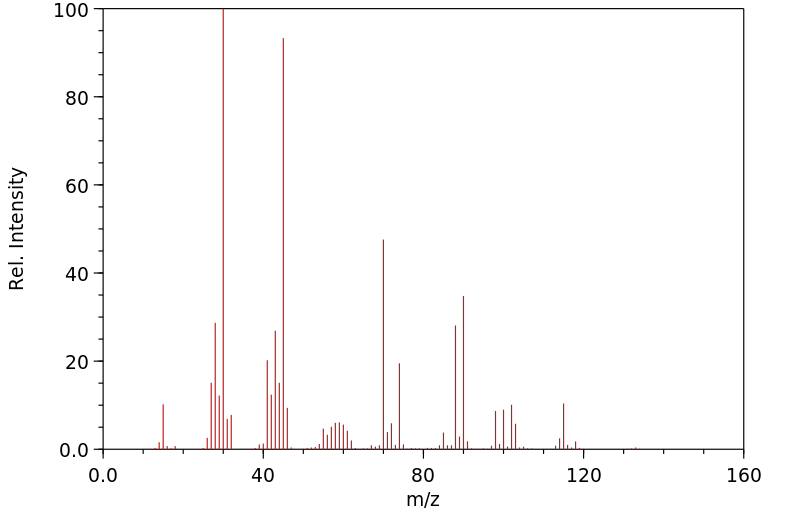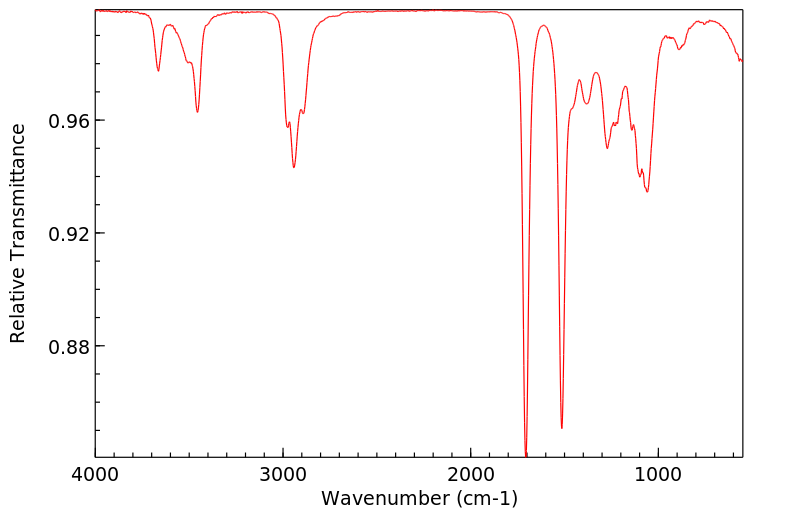乳酰胺 MEA | 5422-34-4
中文名称
乳酰胺 MEA
中文别名
N-(2-羟乙基)乳酰胺;N-(2-羟乙基)-2-羟基丙酰胺;乳酰胺MEA
英文名称
N-(2-hydroxyethyl)lactamide
英文别名
β-Hydroxyethyllactamid;N-(2-hydroxyethyl) lactamide;hydroxyethyl lactamide;N-(2-hydroxy-ethyl)-lactamide;DL-Milchsaeure-(2-hydroxy-aethylamid);N-(2-Hydroxy-aethyl)-lactamid;2-Hydroxy-N-(2-hydroxyethyl)propanamide
CAS
5422-34-4
化学式
C5H11NO3
mdl
MFCD00037805
分子量
133.147
InChiKey
RZCHTMXTKQHYDT-UHFFFAOYSA-N
BEILSTEIN
——
EINECS
——
-
物化性质
-
计算性质
-
ADMET
-
安全信息
-
SDS
-
制备方法与用途
-
上下游信息
-
文献信息
-
表征谱图
-
同类化合物
-
相关功能分类
-
相关结构分类
物化性质
-
沸点:380.3±27.0 °C(Predicted)
-
密度:1,2 g/cm3
-
LogP:-2.31
-
物理描述:Liquid
-
溶解度:Very soluble in water; insoluble in pentane and diethyl ether
-
折光率:1.475-1.481
计算性质
-
辛醇/水分配系数(LogP):-1.4
-
重原子数:9
-
可旋转键数:3
-
环数:0.0
-
sp3杂化的碳原子比例:0.8
-
拓扑面积:69.6
-
氢给体数:3
-
氢受体数:3
安全信息
-
危险类别码:R36/37/38
-
海关编码:2924199090
-
安全说明:S26,S36/37/39
-
危险性防范说明:P261,P264,P270,P271,P280,P301+P312+P330,P302+P352+P312+P362+P364,P304+P340+P312,P501
-
危险性描述:H302+H312+H332
-
储存条件:室温且干燥
SDS
N-(2-羟乙基)乳酰胺 修改号码:5
模块 1. 化学品
产品名称: N-(2-Hydroxyethyl)lactamide
修改号码: 5
模块 2. 危险性概述
GHS分类
物理性危害 未分类
健康危害
急性毒性(经口) 第4级
急性毒性(经皮) 第4级
急性毒性(吸入) 第4级
环境危害 未分类
GHS标签元素
图标或危害标志
信号词 警告
危险描述 吸入或皮肤接触或吞咽有害。
防范说明
[预防] 避免吸入。
只能在室外或通风良好的环境下使用。
使用本产品时切勿吃东西,喝水或吸烟。
处理后要彻底清洗双手。
穿戴防护手套/护目镜/防护面具。
[急救措施] 吸入:将受害者移到新鲜空气处,在呼吸舒适的地方保持休息。若感不适,呼叫解毒
中心/医生。
食入:若感不适,呼叫解毒中心/医生。漱口。
皮肤接触:用大量肥皂和水轻轻洗。
被污染的衣物清洗后方可重新使用。
若感不适:呼叫解毒中心/医生。
[废弃处置] 根据当地政府规定把物品/容器交与工业废弃处理机构。
N-(2-羟乙基)乳酰胺 修改号码:5
模块 3. 成分/组成信息
单一物质/混和物 单一物质
化学名(中文名): N-(2-羟乙基)乳酰胺
百分比: >98.0%(GC)
CAS编码: 5422-34-4
俗名: N-(2-Hydroxyethyl)-2-hydroxypropionamide
分子式: C5H11NO3
模块 4. 急救措施
吸入: 将受害者移到新鲜空气处,保持呼吸通畅,休息。若感不适立即呼叫解毒中心/医生。
皮肤接触: 立即去除/脱掉所有被污染的衣物。用大量肥皂和水轻轻洗。
若皮肤刺激或发生皮疹:求医/就诊。
眼睛接触: 用水小心清洗几分钟。如果方便,易操作,摘除隐形眼镜。继续清洗。
如果眼睛刺激:求医/就诊。
食入: 若感不适,呼叫解毒中心/医生。漱口。
紧急救助者的防护: 救援者需要穿戴个人防护用品,比如橡胶手套和气密性护目镜。
模块 5. 消防措施
合适的灭火剂: 干粉,泡沫,雾状水,二氧化碳
不适用的灭火剂: 棒状水
特殊危险性: 小心,燃烧或高温下可能分解产生毒烟。
特定方法: 从上风处灭火,根据周围环境选择合适的灭火方法。
非相关人员应该撤离至安全地方。
周围一旦着火:如果安全,移去可移动容器。
消防员的特殊防护用具: 灭火时,一定要穿戴个人防护用品。
模块 6. 泄漏应急处理
个人防护措施,防护用具, 使用个人防护用品。远离溢出物/泄露处并处在上风处。确保足够通风。
紧急措施: 泄露区应该用安全带等圈起来,控制非相关人员进入。
环保措施: 防止进入下水道。
控制和清洗的方法和材料: 用合适的吸收剂(如:旧布,干砂,土,锯屑)吸收泄漏物。一旦大量泄漏,筑堤控
制。附着物或收集物应该立即根据合适的法律法规废弃处置。
模块 7. 操作处置与储存
处理
技术措施: 在通风良好处进行处理。穿戴合适的防护用具。防止烟雾产生。处理后彻底清洗双手
和脸。
注意事项: 如果蒸气或浮质产生,使用通风、局部排气。
操作处置注意事项: 避免接触皮肤、眼睛和衣物。
贮存
储存条件: 保持容器密闭。存放于凉爽、阴暗处。
远离不相容的材料比如氧化剂存放。
包装材料: 依据法律。
模块 8. 接触控制和个体防护
工程控制: 尽可能安装封闭体系或局部排风系统,操作人员切勿直接接触。同时安装淋浴器和洗
眼器。
个人防护用品
呼吸系统防护: 防毒面具。依据当地和政府法规。
手部防护: 防护手套。
N-(2-羟乙基)乳酰胺 修改号码:5
模块 8. 接触控制和个体防护
眼睛防护: 安全防护镜。如果情况需要,佩戴面具。
皮肤和身体防护: 防护服。如果情况需要,穿戴防护靴。
模块 9. 理化特性
液体
外形(20°C):
外观: 透明
颜色: 微浅黄色-红黄色
气味: 无资料
pH: 无数据资料
熔点: 无资料
沸点/沸程 无资料
闪点: 无资料
爆炸特性
爆炸下限: 无资料
爆炸上限: 无资料
密度: 1.20
溶解度:
[水] 无资料
[其他溶剂] 无资料
模块 10. 稳定性和反应性
化学稳定性: 一般情况下稳定。
危险反应的可能性: 未报道特殊反应性。
须避免接触的物质 氧化剂
危险的分解产物: 一氧化碳, 二氧化碳, 氮氧化物 (NOx)
模块 11. 毒理学信息
急性毒性: ipr-mus LD50:16300 mg/kg
scu-rat LD50:24 g/kg
对皮肤腐蚀或刺激: 无资料
对眼睛严重损害或刺激: 无资料
生殖细胞变异原性: 无资料
致癌性:
IARC = 无资料
NTP = 无资料
生殖毒性: 无资料
RTECS 号码: OD2400000
模块 12. 生态学信息
生态毒性:
鱼类: 无资料
甲壳类: 无资料
藻类: 无资料
残留性 / 降解性: 无资料
潜在生物累积 (BCF): 无资料
土壤中移动性
log水分配系数: 无资料
土壤吸收系数 (Koc): 无资料
亨利定律 无资料
constaNT(PaM3/mol):
N-(2-羟乙基)乳酰胺 修改号码:5
模块 13. 废弃处置
如果可能,回收处理。请咨询当地管理部门。建议在装有后燃和洗涤装置的化学焚烧炉中焚烧。废弃处置时请遵守
国家、地区和当地的所有法规。
模块 14. 运输信息
联合国分类: 与联合国分类标准不一致
UN编号: 未列明
模块 15. 法规信息
《危险化学品安全管理条例》(2002年1月26日国务院发布,2011年2月16日修订): 针对危险化学品的安全使用、
生产、储存、运输、装卸等方面均作了相应的规定。
模块16 - 其他信息
N/A
模块 1. 化学品
产品名称: N-(2-Hydroxyethyl)lactamide
修改号码: 5
模块 2. 危险性概述
GHS分类
物理性危害 未分类
健康危害
急性毒性(经口) 第4级
急性毒性(经皮) 第4级
急性毒性(吸入) 第4级
环境危害 未分类
GHS标签元素
图标或危害标志
信号词 警告
危险描述 吸入或皮肤接触或吞咽有害。
防范说明
[预防] 避免吸入。
只能在室外或通风良好的环境下使用。
使用本产品时切勿吃东西,喝水或吸烟。
处理后要彻底清洗双手。
穿戴防护手套/护目镜/防护面具。
[急救措施] 吸入:将受害者移到新鲜空气处,在呼吸舒适的地方保持休息。若感不适,呼叫解毒
中心/医生。
食入:若感不适,呼叫解毒中心/医生。漱口。
皮肤接触:用大量肥皂和水轻轻洗。
被污染的衣物清洗后方可重新使用。
若感不适:呼叫解毒中心/医生。
[废弃处置] 根据当地政府规定把物品/容器交与工业废弃处理机构。
N-(2-羟乙基)乳酰胺 修改号码:5
模块 3. 成分/组成信息
单一物质/混和物 单一物质
化学名(中文名): N-(2-羟乙基)乳酰胺
百分比: >98.0%(GC)
CAS编码: 5422-34-4
俗名: N-(2-Hydroxyethyl)-2-hydroxypropionamide
分子式: C5H11NO3
模块 4. 急救措施
吸入: 将受害者移到新鲜空气处,保持呼吸通畅,休息。若感不适立即呼叫解毒中心/医生。
皮肤接触: 立即去除/脱掉所有被污染的衣物。用大量肥皂和水轻轻洗。
若皮肤刺激或发生皮疹:求医/就诊。
眼睛接触: 用水小心清洗几分钟。如果方便,易操作,摘除隐形眼镜。继续清洗。
如果眼睛刺激:求医/就诊。
食入: 若感不适,呼叫解毒中心/医生。漱口。
紧急救助者的防护: 救援者需要穿戴个人防护用品,比如橡胶手套和气密性护目镜。
模块 5. 消防措施
合适的灭火剂: 干粉,泡沫,雾状水,二氧化碳
不适用的灭火剂: 棒状水
特殊危险性: 小心,燃烧或高温下可能分解产生毒烟。
特定方法: 从上风处灭火,根据周围环境选择合适的灭火方法。
非相关人员应该撤离至安全地方。
周围一旦着火:如果安全,移去可移动容器。
消防员的特殊防护用具: 灭火时,一定要穿戴个人防护用品。
模块 6. 泄漏应急处理
个人防护措施,防护用具, 使用个人防护用品。远离溢出物/泄露处并处在上风处。确保足够通风。
紧急措施: 泄露区应该用安全带等圈起来,控制非相关人员进入。
环保措施: 防止进入下水道。
控制和清洗的方法和材料: 用合适的吸收剂(如:旧布,干砂,土,锯屑)吸收泄漏物。一旦大量泄漏,筑堤控
制。附着物或收集物应该立即根据合适的法律法规废弃处置。
模块 7. 操作处置与储存
处理
技术措施: 在通风良好处进行处理。穿戴合适的防护用具。防止烟雾产生。处理后彻底清洗双手
和脸。
注意事项: 如果蒸气或浮质产生,使用通风、局部排气。
操作处置注意事项: 避免接触皮肤、眼睛和衣物。
贮存
储存条件: 保持容器密闭。存放于凉爽、阴暗处。
远离不相容的材料比如氧化剂存放。
包装材料: 依据法律。
模块 8. 接触控制和个体防护
工程控制: 尽可能安装封闭体系或局部排风系统,操作人员切勿直接接触。同时安装淋浴器和洗
眼器。
个人防护用品
呼吸系统防护: 防毒面具。依据当地和政府法规。
手部防护: 防护手套。
N-(2-羟乙基)乳酰胺 修改号码:5
模块 8. 接触控制和个体防护
眼睛防护: 安全防护镜。如果情况需要,佩戴面具。
皮肤和身体防护: 防护服。如果情况需要,穿戴防护靴。
模块 9. 理化特性
液体
外形(20°C):
外观: 透明
颜色: 微浅黄色-红黄色
气味: 无资料
pH: 无数据资料
熔点: 无资料
沸点/沸程 无资料
闪点: 无资料
爆炸特性
爆炸下限: 无资料
爆炸上限: 无资料
密度: 1.20
溶解度:
[水] 无资料
[其他溶剂] 无资料
模块 10. 稳定性和反应性
化学稳定性: 一般情况下稳定。
危险反应的可能性: 未报道特殊反应性。
须避免接触的物质 氧化剂
危险的分解产物: 一氧化碳, 二氧化碳, 氮氧化物 (NOx)
模块 11. 毒理学信息
急性毒性: ipr-mus LD50:16300 mg/kg
scu-rat LD50:24 g/kg
对皮肤腐蚀或刺激: 无资料
对眼睛严重损害或刺激: 无资料
生殖细胞变异原性: 无资料
致癌性:
IARC = 无资料
NTP = 无资料
生殖毒性: 无资料
RTECS 号码: OD2400000
模块 12. 生态学信息
生态毒性:
鱼类: 无资料
甲壳类: 无资料
藻类: 无资料
残留性 / 降解性: 无资料
潜在生物累积 (BCF): 无资料
土壤中移动性
log水分配系数: 无资料
土壤吸收系数 (Koc): 无资料
亨利定律 无资料
constaNT(PaM3/mol):
N-(2-羟乙基)乳酰胺 修改号码:5
模块 13. 废弃处置
如果可能,回收处理。请咨询当地管理部门。建议在装有后燃和洗涤装置的化学焚烧炉中焚烧。废弃处置时请遵守
国家、地区和当地的所有法规。
模块 14. 运输信息
联合国分类: 与联合国分类标准不一致
UN编号: 未列明
模块 15. 法规信息
《危险化学品安全管理条例》(2002年1月26日国务院发布,2011年2月16日修订): 针对危险化学品的安全使用、
生产、储存、运输、装卸等方面均作了相应的规定。
模块16 - 其他信息
N/A
反应信息
-
作为反应物:描述:乳酰胺 MEA 在 ammonium sulfate 、 三乙胺 作用下, 以 苯 为溶剂, 生成 2,2,6-trimethyl-4-(2-trimethylsiloxyethyl)-1-oxa-4-aza-2-silacyclohexan-5-one参考文献:名称:Baukov; Shipov; Kramarova, Russian Journal of Organic Chemistry, 1996, vol. 32, # 8, p. 1216 - 1228摘要:DOI:
-
作为产物:描述:参考文献:名称:PREPARATION OF N-SUBSTITUTED LACTAMIDES BY AMINOLYSIS OF METHYL LACTATE2, 3摘要:DOI:10.1021/jo01148a013
文献信息
-
Skin-care agents containing hydroxyalkyl carboxamides and process申请人:Henkel Kommanditgesellschaft auf Aktien公开号:US04143159A1公开(公告)日:1979-03-06Skin-care, skin-protection, and skin-cleaning agent compositions containing at least one hydroxyalkyl carboxamide as a skin-moisturizing agent, as well as a process for protecting the skin utilizing this composition.皮肤护理、皮肤保护和皮肤清洁剂组合物,包含至少一种羟基烷基羧酰胺作为皮肤保湿剂,以及利用该组合物保护皮肤的过程。
-
A chemical approach for the future of PLA upcycling: from plastic wastes to new 3D printing materials作者:Lin Shao、Yu-Chung Chang、Cheng Hao、Ming-en Fei、Baoming Zhao、Brian J. Bliss、Jinwen ZhangDOI:10.1039/d2gc01745h日期:——or industrial composting. Therefore, it will negatively impact the environment if treated carelessly. In this work, we report a simple PLA upcycling path to turn existing PLA wastes into new 3D printable materials within 48 hours. The ester bonds of PLA can be cleaved efficiently via aminolysis. The obtained monomeric compound was derivatized with methacrylic anhydride, which introduces double bonds随着对 PLA 需求的增加,必须仔细考虑消费后处置策略。虽然我们很乐意拥抱生物塑料的未来,但我们也需要谨慎行事。尽管 PLA 被广泛认为是可生物降解的,但完全降解通常需要在垃圾填埋场或工业堆肥中通常没有的条件。因此,如果处理不当,会对环境产生负面影响。在这项工作中,我们报告了一个简单的 PLA 升级回收路径,可在 48 小时内将现有的 PLA 废料转化为新的 3D 可打印材料。PLA的酯键可以通过以下方式有效裂解氨解。将得到的单体化合物用甲基丙烯酸酐衍生化,甲基丙烯酸酐引入双键,从而得到可交联的单体。与共聚单体和引发剂结合,可生产光固化树脂。树脂可以送入任何市售的光固化 3D 打印机。从 PLA 废料中提取的 3D 打印部件表现出令人印象深刻的性能,拉伸强度为 58.6 MPa,杨氏模量为 2.8 GPa,玻璃化转变温度约为 180 °C。我们的工作展示了一条积极升级 PLA 的新途径,同时最大限度地减少处置需求。
-
Acrylic diester-propionamides and polymers thereof申请人:EASTMAN KODAK CO公开号:US02458422A1公开(公告)日:1949-01-04
表征谱图
-
氢谱1HNMR
-
质谱MS
-
碳谱13CNMR
-
红外IR
-
拉曼Raman
-
峰位数据
-
峰位匹配
-
表征信息
同类化合物
(乙腈)二氯镍(II)
(R)-(-)-α-甲基组胺二氢溴化物
(N-(2-甲基丙-2-烯-1-基)乙烷-1,2-二胺)
(4-(苄氧基)-2-(哌啶-1-基)吡啶咪丁-5-基)硼酸
(11-巯基十一烷基)-,,-三甲基溴化铵
鼠立死
鹿花菌素
鲸蜡醇硫酸酯DEA盐
鲸蜡硬脂基二甲基氯化铵
鲸蜡基胺氢氟酸盐
鲸蜡基二甲胺盐酸盐
高苯丙氨醇
高箱鲀毒素
高氯酸5-(二甲氨基)-1-({(E)-[4-(二甲氨基)苯基]甲亚基}氨基)-2-甲基吡啶正离子
高氯酸2-氯-1-({(E)-[4-(二甲氨基)苯基]甲亚基}氨基)-6-甲基吡啶正离子
高氯酸2-(丙烯酰基氧基)-N,N,N-三甲基乙铵
马诺地尔
马来酸氢十八烷酯
马来酸噻吗洛尔EP杂质C
马来酸噻吗洛尔
马来酸倍他司汀
顺式环己烷-1,3-二胺盐酸盐
顺式氯化锆二乙腈
顺式吡咯烷-3,4-二醇盐酸盐
顺式双(3-甲氧基丙腈)二氯铂(II)
顺式3,4-二氟吡咯烷盐酸盐
顺式1-甲基环丙烷1,2-二腈
顺式-二氯-反式-二乙酸-氨-环己胺合铂
顺式-二抗坏血酸(外消旋-1,2-二氨基环己烷)铂(II)水合物
顺式-N,2-二甲基环己胺
顺式-4-甲氧基-环己胺盐酸盐
顺式-4-环己烯-1.2-二胺
顺式-4-氨基-2,2,2-三氟乙酸环己酯
顺式-3-氨基环丁烷甲腈盐酸盐
顺式-2-羟基甲基-1-甲基-1-环己胺
顺式-2-甲基环己胺
顺式-2-(苯基氨基)环己醇
顺式-2-(苯基氨基)环己醇
顺式-2-(氨基甲基)-1-苯基环丙烷羧酸盐酸盐
顺式-1,3-二氨基环戊烷
顺式-1,2-环戊烷二胺二盐酸盐
顺式-1,2-环戊烷二胺
顺式-1,2-环丁腈
顺式-1,2-双氨甲基环己烷
顺式--N,N'-二甲基-1,2-环己二胺
顺式-(R,S)-1,2-二氨基环己烷铂硫酸盐
顺式-(2-氨基-环戊基)-甲醇
顺-2-戊烯腈
顺-1,3-环己烷二胺
顺-1,3-双(氨甲基)环己烷








